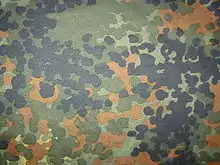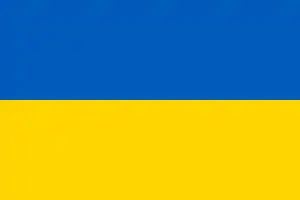Flecktarn
Flecktarn (German pronunciation: [ˈflɛktaʁn]; "mottled camouflage"; also known as Flecktarnmuster or Fleckentarn) is a family of 3-, 4-, 5- or 6-color disruptive camouflage patterns, the most common being the five-color pattern, consisting of dark green, light green, black, red brown and green brown or tan depending on the manufacturer. The original German 5-color pattern was designed for use in European temperate woodland terrain. A 3-color variation called Tropentarn (formerly Wüstentarn) is intended for arid and desert conditions; the German Bundeswehr wore it in Afghanistan.
| Flecktarn | |
|---|---|
 Flecktarn camouflage woodland fabric swatch | |
| Type | Military camouflage pattern |
| Place of origin | Germany |
| Service history | |
| In service | 1990–present |
| Used by | See Users |
| Wars | Bosnian War Kosovo War War in Afghanistan Iraq War War in Donbass[1] |
| Production history | |
| Designed | 1976 |
| Variants | See Variants |
The original German 5-color flecktarn has been adopted, copied and modified by many countries for their own camouflage patterns.
History
The German Army started experimenting with camouflage patterns before World War II, and some army units used Splittermuster ("splinter pattern") camouflage, first issued in 1931.[2] Waffen-SS combat units used various patterns from 1935 onwards. Many SS camouflage patterns were designed by Prof. Johann Georg Otto Schick.[3]
Modern patterns

In 1976, the Bundeswehr in Germany developed a number of prototype camouflage patterns, to be trialled as replacements for the solid olive-grey "moleskin" combat uniform. At least four distinct camouflage patterns were tested during Bundeswehr Truppenversuch 76 ("Bundeswehr Troop Trial 76"). These were based on patterns in nature:[2] one was called "Dots" or "Points"; another was called "Ragged Leaf" or "Saw Tooth Edge"; another was based on pine needles in winter.[2]
Designed by the German company Marquardt & Schulz, several patterns were developed and tested by the German military. The pattern named "Flecktarn B" was chosen as the final pattern for use. The word flecktarn is a composite formed from the German words Fleck (spot, blot, patch or pattern) and Tarnung (camouflage). The Bundeswehr kept its green combat dress throughout the 1980s, however, while trials were conducted. Flecktarn was only widely introduced in 1990 in a newly reunited Germany.[2]
In Germany, the Flecktarn camouflage pattern is used by all Bundeswehr service branches, the Heer (army), the Luftwaffe (air force), some Marine (navy) units and even the Sanitätsdienst (medical service). Its official name is 5 Farben-Tarndruck der Bundeswehr (5-color camouflage print of the Bundeswehr).[4] This temperate Flecktarn 5-color scheme consists of 15% light green, 20% light olive, 35% dark green, 20% brown and 10% black.[4] The Dutch military tested the pattern and rejected it, allegedly because it was "too aggressive".[2] Flecktarn was seen as controversial because of its resemblance to the Waffen-SS "peas" and "oak leaves" patterns, which also used dots in various colors.[2]
In 2016, there were tests being conducted by the Research Institute of materials and property of the Bundeswehr (Wehrwissenschaftliche Institut für Werk- und Betriebsstoffe – WIWeB) on a new pattern called Multitarn as a potential replacement for Flecktarn.[5]
Variants
Flecktarn is the basis for the Bundeswehr's Tropentarn desert camouflage,[6] the Danish military's T/78 and M/84 camouflage, including a desert variation of the Danish pattern. Several variations of the Flecktarn camouflage are also used by the Russian military, one is called Sever ("north"), sometimes also referred as Flectarn-D while another variant is called Tochka-4. Other country's variations include Japan's Type II Camouflage;[7] Type 03 Plateau camouflage, used by the Chinese military in Tibet[7] (and some Russian Special Forces); and an urban variation used by some police units in Poland.[8] A Chinese-made commercially available variant with 3 of the 5 color screens reversed has been used by some units of the Kyrgyzstan military.[9]
In 2013, the German company Mil-Tec introduced a new version of Flecktarn, called the Arid Flecktarn. It retains the 5-color pattern but with the colour scheme resembling that of MultiCam.[10] It remains a commercial variant and is not in use by any world military.
 Austrian Flecktarnmuster
Austrian Flecktarnmuster Chinese Tibetarn
Chinese Tibetarn Belgian Flecktarn
Belgian Flecktarn
 Danish M/01
Danish M/01 French Experimental Desert Flecktarn
French Experimental Desert Flecktarn German Flecktarn
German Flecktarn German Tropentarn
German Tropentarn Indian Flecktarn
Indian Flecktarn Japanese Jieitai
Japanese Jieitai Japanese Winter Jieitai
Japanese Winter Jieitai Japanese Desert Jieitai
Japanese Desert Jieitai Polish Urban Flecktarn
Polish Urban Flecktarn
wz AT 1 PLAMIAK Polish Woodland Flecktarn
Polish Woodland Flecktarn
Gepard Russian Flectar-D
Russian Flectar-D Commercial Arid Flecktarn
Commercial Arid Flecktarn Commercial Schneetarn snow camouflage
Commercial Schneetarn snow camouflage
Users
 Austria: Used by EKO Cobra as helmet covers for their Ulbrirchts AM-95 helmets.[11]
Austria: Used by EKO Cobra as helmet covers for their Ulbrirchts AM-95 helmets.[11] Germany: Used by Bundeswehr.[6]
Germany: Used by Bundeswehr.[6] Georgia: Some used with Georgian troops in KFOR.[12]
Georgia: Some used with Georgian troops in KFOR.[12] Japan: Uses a four color variant, often called Jietai (自衛隊), in several patterns [13][14]
Japan: Uses a four color variant, often called Jietai (自衛隊), in several patterns [13][14] Ukraine: Used by some Ukrainian forces including
Ukraine: Used by some Ukrainian forces including
- Azov Regiment[1]
- Donbas Battalion[15]
- Bohdan Company[16]
- Ivano-Frankivsk Battalion[17]
- Kherson Company[18]
- Sicheslav Company[19]
- Skif Battalion[20]
- Sumy Company[21]
- Shtorm Battalion[22]
- Chernihiv Company[23]
- Dnipro-1 Regiment[24]
- Mykolaiv Battalion[25]
- Poltava Battalion[26]
- Vinnytsya-2 Company[27]
- Luhansk-1 Battalion[28]
- Lviv Battalion[29]
- Myrotvorets Regiment[30]
- Kyiv Regiment[31]
- Lavender Company[32]
- Kharkiv Battalion[33]
- 1st Assault Company[34]
- 53rd Mechanized Brigade[35]
Non-State Actors
- Atomwaffen Division[36]
- Kosovo Liberation Army[12]
- Republican Resistance or Óglaigh na hÉireann (ÓnaÉ)[37]
References
- "Azov Regiment". Military Land. Retrieved 31 July 2018.
- Newark, Tim (2007). Camouflage. Thames and Hudson. pp. 133–134, 157. ISBN 978-0-500-51347-7.
- Dougherty 2017, p. 45-47.
- TL 8305-0290: 5 Farben-Tarndruck der Bundeswehr (PDF; 242 kB) (in German)
- https://defence-blog.com/army/new-multitarn-patterns-for-the-bundeswehr.html
- "Uniformen der Bundeswehr" (in German). Bundeswehr. Retrieved 22 August 2016.
- Dougherty 2017, p. 74.
- SZOŁUCHA, BARTOSZ. "New Uniforms for Metro PD". special-ops.pl (in Polish). MEDIUM Group. Retrieved 22 November 2016.
- https://i44.servimg.com/u/f44/17/04/56/80/kyrgyz10.jpg{%5B%5D
- "M/84 udgave af "Multicam" kunne se sådan ud" [M/84 Camouflage Version of “MultiCam” Could Have Looked Like This]. Krigeren.dk (in Danish). Retrieved 21 January 2016.
- Neville 2017, p. 10.
- https://web.archive.org/web/20140322205738/http://www.kamouflage.net/camouflage/00009.php
- https://www.camopedia.org/index.php?title=Japan
- https://fareastmilsim.com/jsdf-equipment
- http://militaryland.net/ukraine/national-guard/donbas-battalion/
- http://militaryland.net/ukraine/special-police-forces/bohdan-company/
- http://militaryland.net/ukraine/special-police-forces/ivano-frankivsk-battalion/
- http://militaryland.net/ukraine/special-police-forces/kherson-company/
- http://militaryland.net/ukraine/special-police-forces/sicheslav-company/
- http://militaryland.net/ukraine/special-police-forces/skif-battalion/
- http://militaryland.net/ukraine/special-police-forces/sumy-company/
- http://militaryland.net/ukraine/special-police-forces/shtorm-battalion/
- http://militaryland.net/ukraine/special-police-forces/chernihiv-company/
- http://militaryland.net/ukraine/special-police-forces/dnipro1-regiment/
- http://militaryland.net/ukraine/special-police-forces/mykolaiv-battalion/
- http://militaryland.net/ukraine/special-police-forces/poltava-battalion/
- http://militaryland.net/ukraine/special-police-forces/vinnytsya2-company/
- http://militaryland.net/ukraine/special-police-forces/luhansk1-battalion/
- http://militaryland.net/ukraine/special-police-forces/lviv-battalion/
- http://militaryland.net/ukraine/special-police-forces/myrotvorets-regiment/
- http://militaryland.net/ukraine/special-police-forces/kyiv-regiment/
- http://militaryland.net/ukraine/special-police-forces/lavender-company/
- http://militaryland.net/ukraine/special-police-forces/kharkiv-battalion/
- http://militaryland.net/ukraine/volunteer-corps/1st-assault-company/
- http://militaryland.net/ukraine/armed-forces/53rd-mechanized-brigade/
- Beckhusen, Robert (24 August 2017). "Advocates of Neo-Nazi 'Lone Wolf' Terror Are Aiming to Exploit Charlottesville". War Is Boring. Retrieved 26 September 2018.
- https://ansionnachfionn.com/2016/08/10/the-oglaigh-na-heireann-propaganda-demonstration-in-derry/
Bibliography
- Dougherty, Martin (2017). Camouflage at War: An Illustrated Guide from 1914 to the Present Day. London, UK: Amber Books. ISBN 978-1782744986.
- Neville, Leigh (2017). European Counter-Terrorist Units 1972–2017. Oxford: Osprey Publishing. ISBN 978-1472825278.
| Wikimedia Commons has media related to Flecktarn. |
.jpg.webp)